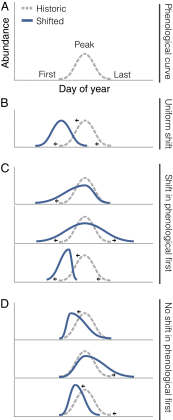Shifts in flowering phenology reshape a subalpine plant community
- PMID: 24639544
- PMCID: PMC3977233
- DOI: 10.1073/pnas.1323073111
Shifts in flowering phenology reshape a subalpine plant community
Erratum in
-
Correction for CaraDonna et al., Shifts in flowering phenology reshape a subalpine plant community.Proc Natl Acad Sci U S A. 2018 Oct 16;115(42):E9993. doi: 10.1073/pnas.1815637115. Epub 2018 Oct 8. Proc Natl Acad Sci U S A. 2018. PMID: 30297401 Free PMC article. No abstract available.
Abstract
Phenology--the timing of biological events--is highly sensitive to climate change. However, our general understanding of how phenology responds to climate change is based almost solely on incomplete assessments of phenology (such as first date of flowering) rather than on entire phenological distributions. Using a uniquely comprehensive 39-y flowering phenology dataset from the Colorado Rocky Mountains that contains more than 2 million flower counts, we reveal a diversity of species-level phenological shifts that bring into question the accuracy of previous estimates of long-term phenological change. For 60 species, we show that first, peak, and last flowering rarely shift uniformly and instead usually shift independently of one another, resulting in a diversity of phenological changes through time. Shifts in the timing of first flowering on average overestimate the magnitude of shifts in the timing of peak flowering, fail to predict shifts in the timing of last flowering, and underrepresent the number of species changing phenology in this plant community. Ultimately, this diversity of species-level phenological shifts contributes to altered coflowering patterns within the community, a redistribution of floral abundance across the season, and an expansion of the flowering season by more than I mo during the course of our study period. These results demonstrate the substantial reshaping of ecological communities that can be attributed to shifts in phenology.
Keywords: growing season; no-analogue community; phenological mismatch; phenology curve; species interactions.
Conflict of interest statement
The authors declare no conflict of interest.
Figures




References
-
- Parmesan C. Influences of species, latitudes and methodologies on estimates of phenological response to global warming. Glob Change Biol. 2007;13(9):1860–1872.
-
- Fitter AH, Fitter RS. Rapid changes in flowering time in British plants. Science. 2002;296(5573):1689–1691. - PubMed
Publication types
MeSH terms
LinkOut - more resources
Full Text Sources
Other Literature Sources
Molecular Biology Databases

